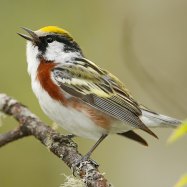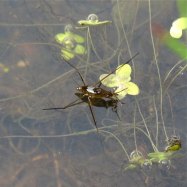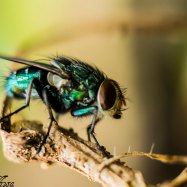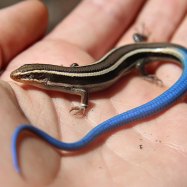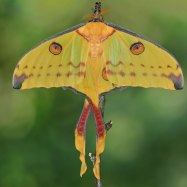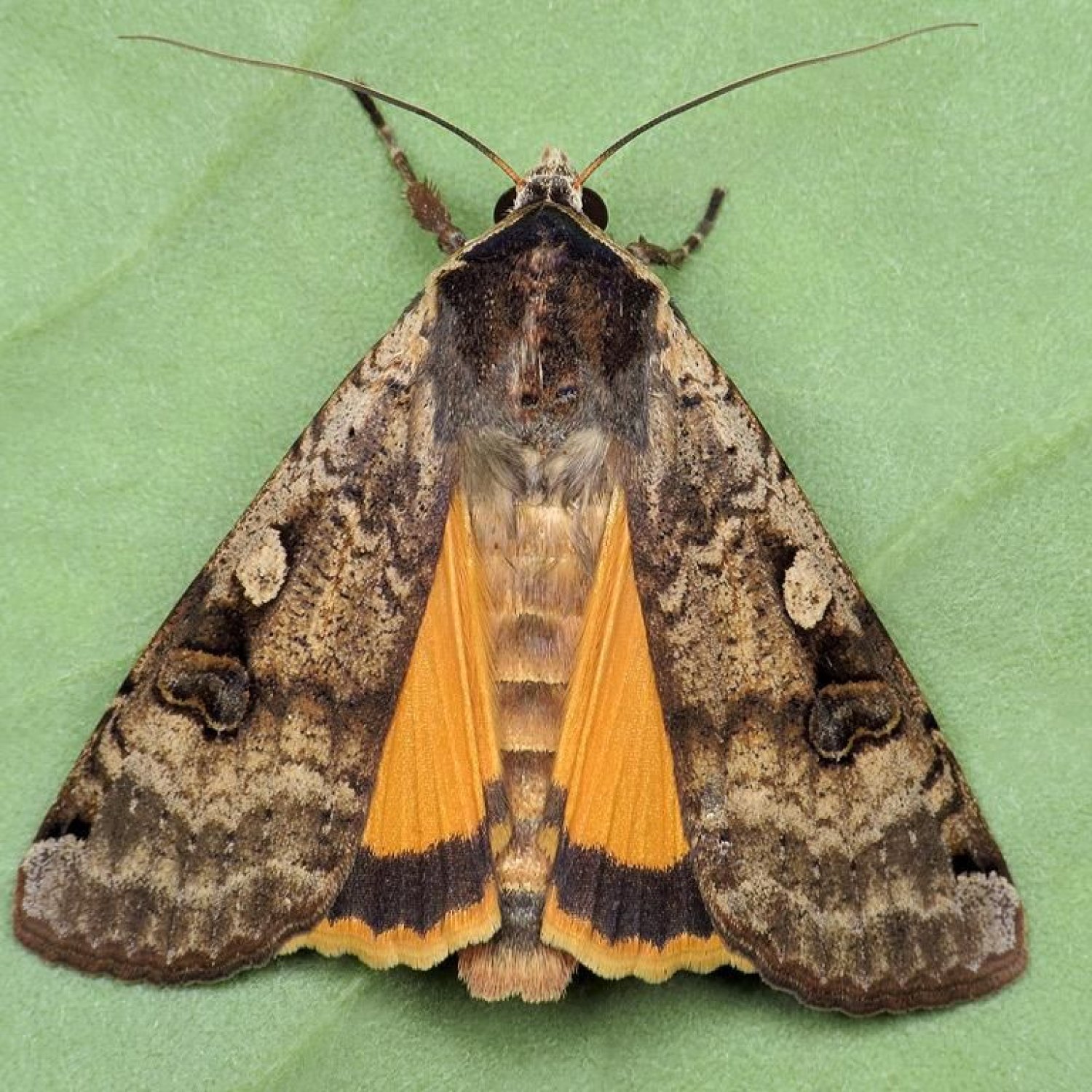
Underwing Moth
2.0-3.5 inches
Underwing Moths are stunning insects found in the Eastern United States. With a body length of 2.0-3.5 inches and a medium-sized body shape, these moths have broad, rounded wings. Belonging to the Erebidae family, they are known for their beautiful underwing patterns. Keep an eye out for these unique creatures on your next outdoor adventure! #UnderwingMoth #Erebidae #EasternUS #naturelovers
Animal Details Summary:
Common Name: Underwing Moth
Kingdom: Animalia
Habitat: Woodlands, forests
The Enigmatic Underwing Moth: A Closer Look into Nature's Master of Disguise
Nature has a way of captivating our hearts and imaginations with its vast array of creatures, each with their unique characteristics and adaptations. Among these fascinating creatures is the Underwing Moth, scientifically known as Catocala. This moth belongs to the order Lepidoptera, the same group as butterflies and other moths, and is a true marvel of nature.The Underwing Moth is aptly named for its distinctive coloration, with the forewings usually dull and camouflaged, while the hindwings are brightly colored, often startling the observer when in flight Underwing Moth. In this article, we will delve deeper into the world of the Underwing Moth, discovering its habitat, feeding habits, geographical distribution, and other fascinating facts.
The Classification of the Underwing Moth
Before we delve into the world of this enigmatic creature, let us first familiarize ourselves with its classification within the animal kingdom. The Underwing Moth belongs to the Kingdom Animalia, which comprises all animals on Earth. It is further classified under the phylum Arthropoda, which includes animals with jointed legs and a segmented body, such as insects, spiders, and crustaceans.The Underwing Moth falls under the class Insecta, the largest group of animals in the animal kingdom, with over a million described species. Like all other insects, the Underwing Moth has six legs, three body parts (head, thorax, and abdomen), and wings attached to the thorax.
It belongs to the order Lepidoptera, which means "scale wings" in Greek. This order includes butterflies and moths, known for their distinctive wings covered with tiny scales that give them their vibrant colors and patterns. Lepidopterans also undergo a complete metamorphosis, starting as eggs, then developing into caterpillars, pupae, and finally emerging as adults Utonagan.
The Underwing Moth belongs to the family Erebidae, which translated means "evening" or "night", as most of its members are nocturnal. This family also encompasses other notable moths, such as the tiger moths, lichen moths, and owlet moths.
The Habitat of the Underwing Moth
The Underwing Moth is commonly found in woodlands and forests, specifically in the Eastern United States. It favors areas with abundant vegetation and trees, providing ample food sources and shelter. These moths are rarely found in open fields or prairies, preferring the dense canopy of the forest.In their natural habitat, Underwing Moths have evolved to blend seamlessly with their surroundings. Their forewings are typically dull-colored, with variations of brown, gray, and black, making them almost invisible when resting on tree bark or in a pile of leaves. However, it is when they spread their wings that their true colors come to light.
The Feeding Habits of the Underwing Moth
Like most moths, the Underwing Moth is a pollinator, and its primary food source is nectar from flowers. Although they have a sucking mouthpart, they do not feed on blood like mosquitoes or other blood-feeding insects. Instead, they use their long proboscis to reach deep into flowers, sipping on nectar.These moths play an essential role in ecosystems as pollinators, transferring pollen from flower to flower, helping with cross-pollination and plant reproduction. They are especially important in forests, where they contribute to the diversity and abundance of plant species.
The Underwing Moth's Distribution and Country of Origin
The Underwing Moth is native to North America, with its range extending from the United States to Canada. It is mainly found in the eastern part of the United States, with some species also found in the western states, such as California and Colorado. However, their abundance varies depending on their preferred habitats.These moths are endemic to the United States and Canada, meaning they are not found in any other part of the world naturally. However, with the increase in global trade and transportation, there have been sightings of Underwing Moths in other countries, thought to be accidentally transported through goods or shipments.
An Intimate Look into the Underwing Moth
Now that we have explored the basic characteristics and behaviors of the Underwing Moth let us take a closer look at its physical attributes. These moths are known for their striking wing patterns, giving them their unique appearance.The Underwing Moth is a medium-sized moth, with an average length of 2.0-3.5 inches. They have a wide wingspan and a medium build, with a broad, rounded shape to their wings. Their wings are covered in tiny scales, with the hindwings bearing the most vibrant colors.
On their hindwings, which are generally exposed when in flight, you can find a variety of colors and patterns. Some species bear bold bands of orange, red, or yellow, while others have striking blue, purple, and even green hues. These bright colors are also thought to act as a distraction for predators, giving the moths time to escape.
On the other hand, the forewings, which are usually hidden when at rest, have a more muted coloration. They come in variations of brown, gray, and black, with small and subtle patterns that blend in with tree bark and other vegetation.
The Fascinating World of Mimicry in Underwing Moths
Aside from their remarkable coloration, Underwing Moths are also known for their ability to mimic other animals, especially their predators. This remarkable adaptation is known as mimicry and is used to confuse and deter predators from attacking them.One species of Underwing Moth has evolved to mimic a honeybee, complete with yellow and black stripes on its hindwings and even wingspan similar to a honeybee's. This clever disguise helps the moth escape predators that avoid attacking stinging insects, believing them to be harmful or unappetizing.
Another species mimics the appearance of dead leaves, with intricate patterns on its forewings resembling the veins of a leaf and speckles that mimic the decaying look of a fallen leaf. This allows the moth to blend in seamlessly with its surroundings, making it almost invisible to predators.
The Importance of Studying Underwing Moths
The Underwing Moth remains one of the most intriguing and mysterious creatures in the animal kingdom. Its ability to adapt and survive in its natural habitat is truly remarkable, making it a subject of study for many scientists and researchers.Studying these moths can also give us a better understanding of the delicate balance of ecosystems, particularly in forests. With habitat destruction and climate change posing threats to these vital areas, learning about the Underwing Moth and its role as a pollinator can help us make informed decisions in protecting our planet's biodiversity.
In Conclusion
In conclusion, the Underwing Moth, with its remarkable coloration, mimicry, and pollination, is a true symbol of the beauty and complexity of nature. With its diverse range and unique characteristics, it continues to fascinate and captivate all who have the privilege of encountering it.From its classification within the animal kingdom to its crucial role in sustaining ecosystems, the Underwing Moth is a creature worthy of our appreciation and admiration. As we continue to explore and learn about this enigmatic moth, let us also remember to do our part in preserving its natural habitat and protecting it for generations to come.

Underwing Moth
Animal Details Underwing Moth - Scientific Name: Catocala
- Category: Animals U
- Scientific Name: Catocala
- Common Name: Underwing Moth
- Kingdom: Animalia
- Phylum: Arthropoda
- Class: Insecta
- Order: Lepidoptera
- Family: Erebidae
- Habitat: Woodlands, forests
- Feeding Method: Sucking nectar from flowers
- Geographical Distribution: North America
- Country of Origin: United States and Canada
- Location: Eastern United States
- Animal Coloration: Varies, typically dull colors on forewings and bright colors on hindwings
- Body Shape: Medium-sized moths with broad, rounded wings
- Length: 2.0-3.5 inches
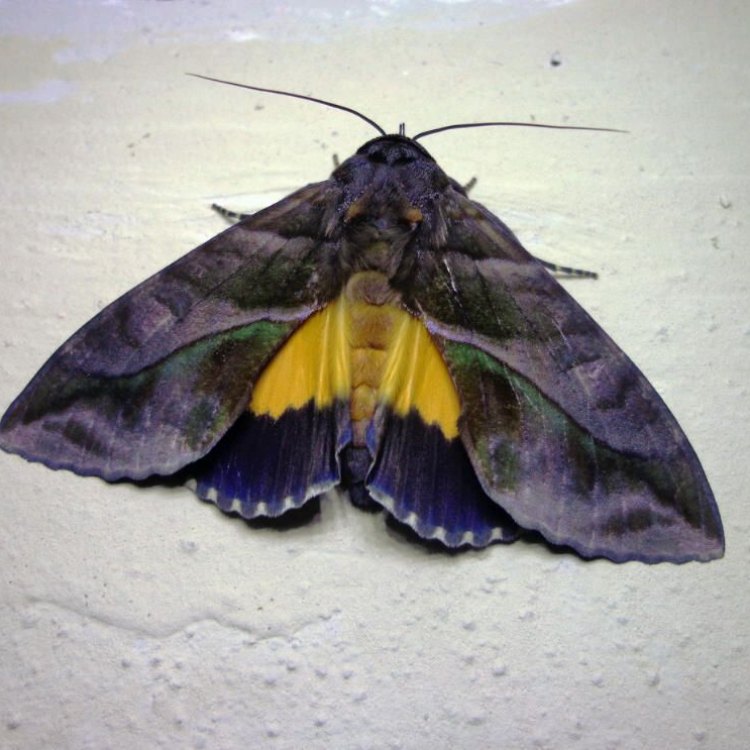
Underwing Moth
- Adult Size: Medium-sized
- Average Lifespan: 1-2 weeks
- Reproduction: Sexual reproduction
- Reproductive Behavior: Females release pheromones to attract males
- Sound or Call: None
- Migration Pattern: No long-distance migrations
- Social Groups: Solitary
- Behavior: Nocturnal, active at night
- Threats: Habitat loss, pesticide use
- Conservation Status: Not evaluated
- Impact on Ecosystem: Pollinators
- Human Use: None
- Distinctive Features: Underwing moths have bright hindwings that are hidden when at rest
- Interesting Facts: When threatened, the underwing moth flashes its brightly colored hindwings to startle predators
- Predator: Birds
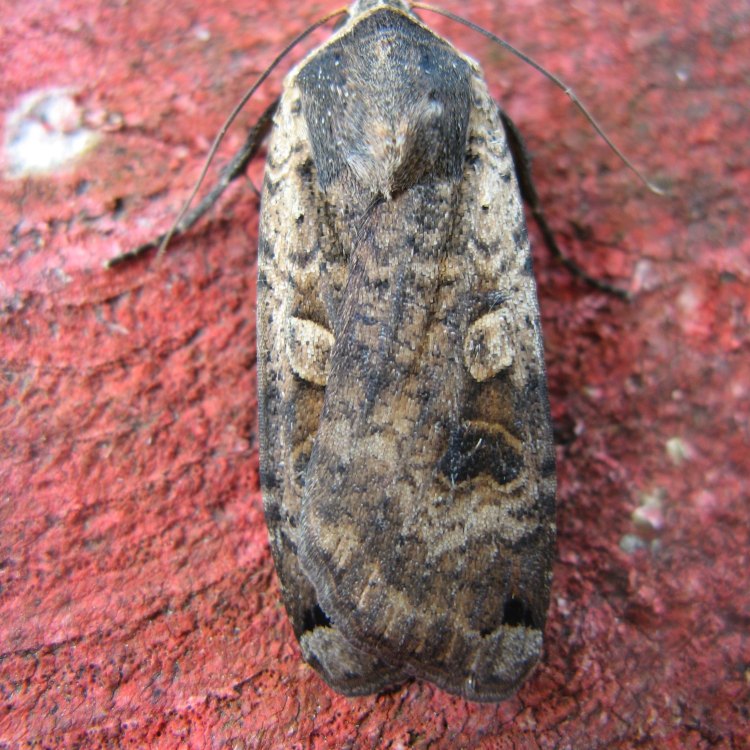
Catocala
The Fascinating World of Underwing Moths
The world of insects is vast and varied, with over one million identified species. Among these, moths hold a special place, known for their delicate beauty and intricate patterns. One particular species of moth that stands out is the underwing moth.With its distinctive features and unique behaviors, the underwing moth is truly a fascinating insect PeaceOfAnimals.Com. In this article, we will delve deeper into the world of underwing moths, exploring their interesting facts, behaviors, and impact on the ecosystem.
A Medium-Sized Beauty
The underwing moth is a medium-sized insect, with an average wingspan of 3-4 inches. It belongs to the genus Catocala, which comprises over 250 species of underwing moths found across North America, Europe, and Asia.One of the notable physical characteristics of underwing moths is their hindwings, which are bright and colorful, in stark contrast to their dull-colored forewings. This unique feature is what gives these moths their name, as their brightly colored hindwings are hidden when they are at rest, "under" their forewings.
A Brief Life Span
The average lifespan of an underwing moth is only 1-2 weeks, with some species living up to a month. Despite their short life span, these moths play a vital role in the ecosystem.Reproduction and Behavior
Like most moths, underwings reproduce through sexual reproduction. Male moths are attracted to females through the release of pheromones, chemical substances that act as a signaling mechanism Uakari. Once mated, the female lays her eggs on the underside of leaves, and the cycle continues.Underwing moths are solitary creatures and do not form social groups. They are also nocturnal, meaning they are active at night, which is when they are most often seen fluttering around outdoor lights.
Not Migratory, but Important Pollinators
Unlike some other insect species, underwing moths do not engage in long-distance migrations. They prefer to stay in one place, with their habitat usually ranging from woodlands, forests, and even urban areas.Despite not being migratory, underwing moths play a crucial role in pollinating plants. As they move from flower to flower, they transfer pollen, assisting in plant reproduction and contributing to the growth of various plant species.
Threats to the Underwing Moth
Sadly, like many other insect species, underwing moths face numerous threats to their survival. Habitat loss is one of the biggest challenges faced by these moths, as widespread deforestation and urbanization continue to destroy their natural habitats.Another significant threat to underwing moths is pesticide use. Pesticides are chemicals used to kill pests, including insects, in agricultural and urban settings. Unfortunately, these chemicals do not discriminate and can harm beneficial insects, like underwing moths, in the process.
A Conservation Conundrum
Despite being a vital pollinator and contributing to the ecosystem, the underwing moth is not evaluated for its conservation status. This means that there is a lack of information regarding the population and distribution of these moths, making it challenging to assess their conservation needs.Moreover, due to the vast number of underwing moth species, monitoring each one's conservation status is a daunting task. This has led to a lack of conservation efforts and funding for this unique insect.
A Thrilling Defense Mechanism
One of the most fascinating facts about underwing moths is their defense mechanism. When threatened, these moths have a unique way of protecting themselves – by flashing their brightly colored hindwings.When predators, such as birds, approach an underwing moth, they suddenly lift their forewings, revealing their bright hindwings. This sudden burst of color startles and confuses predators, giving the moth a chance to escape.
Predators of the Underwing Moth
Despite their clever defense mechanism, underwing moths do have several predators. Birds, in particular, are the primary predators of these moths, as they are quick and agile enough to catch them mid-flight.The Underwing Moth and Human Use
Unlike other insects, underwing moths do not have any apparent human use. However, their presence in the ecosystem plays a vital role in pollination and maintaining a healthy balance within the environment.In recent years, there has been a rise in interest for underwing moths in the field of entomology, with scientists studying their unique characteristics and behaviors to understand more about these beautiful insects.
Conclusion
In conclusion, the underwing moth is an incredible species that deserves our attention and conservation efforts. With their distinctive features, fascinating behaviors, and impact on the ecosystem, these moths are an essential part of our natural world.As we continue to learn more about these beautiful insects, it is crucial to raise awareness about their threatened existence and work towards preserving their habitats. After all, it is only through the conservation of underwing moths that we can ensure a healthy and thriving ecosystem for generations to come.
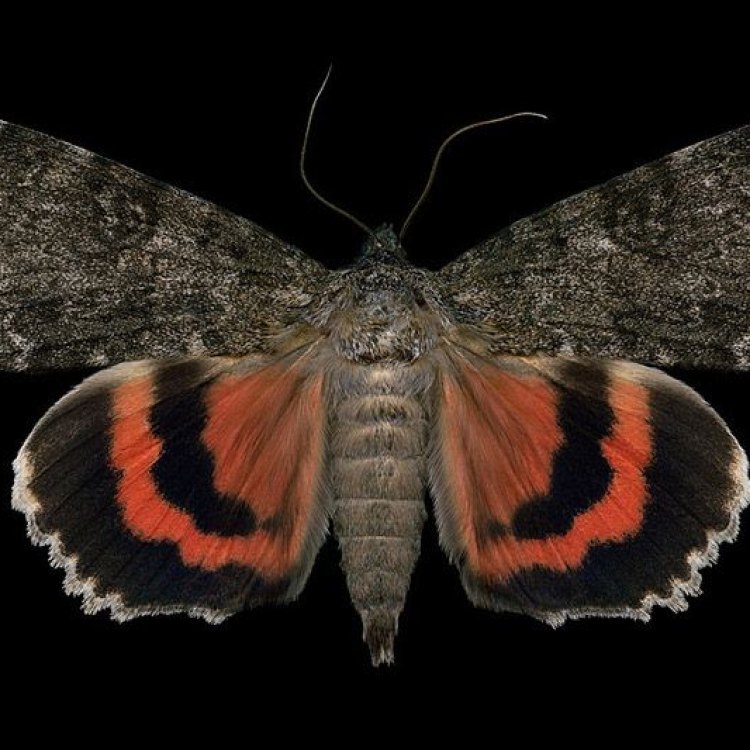
The Enigmatic Underwing Moth: A Closer Look into Nature's Master of Disguise
Disclaimer: The content provided is for informational purposes only. We cannot guarantee the accuracy of the information on this page 100%. All information provided here may change without prior notice.



